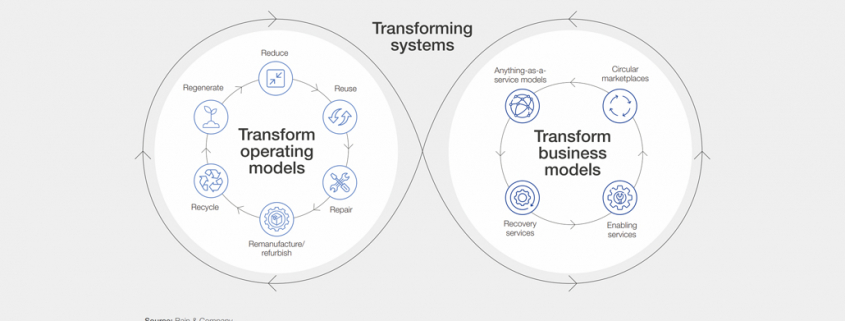Unlocking New Value through Transformation of Industries
In January this year, the World Economic Forum published a new White Paper: “Circular Transformation of Industries: Unlocking New Value in a Resource-Constrained World”.
The Circular Transformation of Industries is a new multi-stakeholder initiative at the World Economic Forum that aims to enable a growing, resilient and sustainable economy through adopting circularity at scale. According to Kristin Hughes (Director of Resource Circularity and Member of the Executive Committee, World Economic Forum) and Francisco Betti (Head of Advanced Manufacturing and Value Chains, World Economic Forum), organizations can transform with a more holistic approach to circularity initiatives, creating more adaptable operating and business models and contributing to system-wide change.
Industries and governments have set ambitious environmental targets for the next 10–20 years, the authors stated in the article “Here’s how we can turn more industries into circular economies”. The parties would aim to achieve supply-chain resilience, reach net zero and dramatically reduce waste, all while driving productivity, innovation and economic growth to meet rapidly changing consumer expectations. “That’s already an unprecedented amount of change, and these visionary efforts operate in a challenging and uncertain geopolitical landscape,” Kristin Hughes and Francisco Betti underlined. Achieving such commitments would require bold change. “Transforming business models and supply chains is no easy task. It requires system-wide adaptation to how we make, sell, use, reuse or recycle products and how the global economy operates overall.”
“Circularity is not a new concept,” they wrote. “In the past 20 years, businesses, industries and governments have experimented with circularity initiatives, mainly focused on recycling and waste management. Very few have succeeded at large-scale implementation, and even fewer have considered a full shift of the value chain.” A recent Bain & Company survey found that about 60 percent of active circularity initiatives have not reached scale. “Early circularity initiatives are most frequently held back by a lack of technology capabilities, inconsistent industry standards and a lack of strong connections with other players in the industry.” In this context, the authors referred to Jagjit Singh Srai, Director of Research in the Department of Engineering at the University of Cambridge: “Transformation to a circular economy will require cross-industry collaborations where systems thinking leverages advances in materials, production and digital technologies. These collaborations and technologies will underpin resource-efficient operating and business models of the future.”
According to the authors, focusing primarily on recycling inputs and redirecting waste flows is an easier and more controlled option, but it would limit the potential to scale circularity initiatives. “Without a holistic approach across multiple supply chains, the circularity movement has hit a fundamental barrier: the extra cost and complexity of becoming circular outweigh the added benefits.” The current value proposition had not convinced businesses and consumers to make circularity a reality or to undertake broader, systemic changes. “Circularity initiatives to date have shown that isolated efforts are not enough; slow, incremental change is ineffective,” they are convinced.
Enabling economic growth
The authors of the White Paper believe that organizations that embark on circular transformations and create more adaptable operating and business models will be better positioned to prosper, even in times of disruption, while contributing to sustainable growth. According to Hernan Saenz, Senior Partner and Global Head of Performance Improvement at Bain & Company, circularity “is not just about protecting the climate and our planet’s biocapacity, but about enabling massive and resilient economic growth – circular models and operations are the future, and the companies that get there first will establish a competitive advantage.”
Transforming how the global economy operates would go way beyond the first step of companies building circular networks. It requires bold thinking to reshape operating and business models, build new systems and change consumer behavior, Kristin Hughes and Francisco Betti wrote. These broader actions, in turn, would reconfigure industry value chains and set in motion a more systemic, sustainable approach to resources worldwide while unlocking economic growth.
Advice for policymakers
Meanwhile, governments can expedite the process by providing the right infrastructure and standards for circularity, the authors emphasized. Policymakers had an essential role to play.
According to the information, the European Union has been at the forefront of circular policy efforts creating frameworks such as the Circular Economy Action Plan (CEAP), Extended Producer Responsibility (EPR) and the new battery directive. Other countries were creating own programs, including the E-waste Producer Responsibility Organisation Nigeria (EPRON) and Singapore’s Resource Sustainability Act (RSA) to manage electrical waste. “Although these programs build momentum, achieving a systemic shift will require more ambitious and holistic initiatives that are broader in scope, interconnected among industries and aligned across countries and regions in order to create global standards, trade rules and consistent incentive structures.”
As emphasized by Kristin Hughes and Francisco Betti, industries and policymakers turn towards resource circularity to help secure, transform and diversify the supply of industry-critical materials while reducing the need for extraction and associated emissions. Industry coalitions have worked with future-focused governments to establish the incentives, policy frameworks, standards, operating models, certifications and circularity-focused capabilities necessary to scale. In some markets, business models have been transformed to decrease demand and increase recovery potential and actual recovery of these resources, partially mitigating the demand-supply gap going forward.
Forward-looking leadership teams were advised to focus on these crucial questions:
- What are the most effective and profitable circular models to support our growth and sustainability efforts and navigate global disruptions?
- How can organizations build a network of interconnected supply chains to enable new circular models?
- How can we achieve systems-wide change that dramatically increases the number of interconnected circular supply chains?
(Published in GLOBAL RECYCLING Magazine 1/2023, Page 6, Graphic: Bain & Company)








